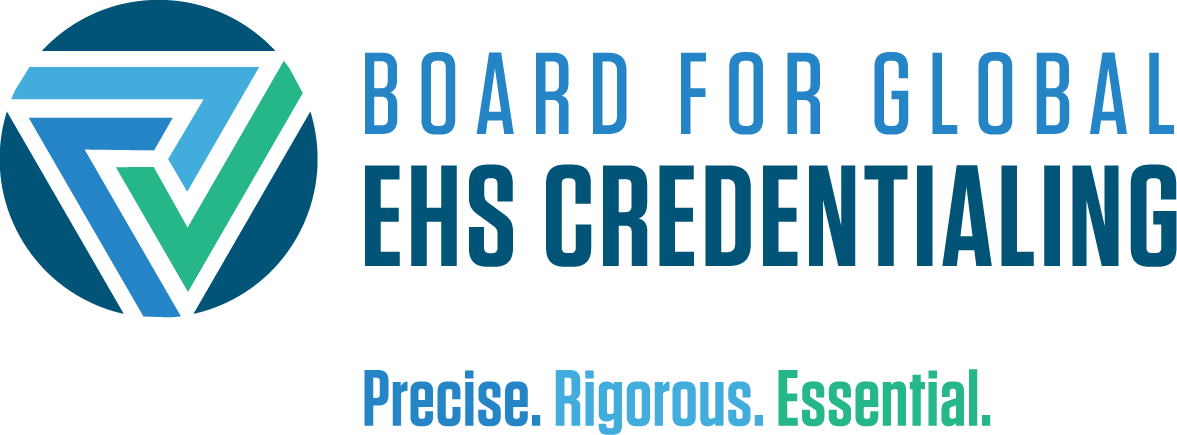Preparing for the CPEA Exam
The BGC Board encourages you to consider your knowledge and experience and to assess your recognized strengths and weaknesses. Self-study, specific training, and group discussions are recognized methods of improving perceived weaknesses. However, the Board does not endorse or support specific training courses, study guides, or other activities that are intended or purported to be prepared for its examinations.
Publications and References: Environmental Compliance
BGC examination questions are supported by many sources that reflect the underlying purposes and principles of EHS auditing as well as the current knowledge that is expected in Environmental Compliance. Frequently cited resources are provided below, but the list is not exhaustive:
- Achieving Environmental Management Standards – M. J. Gilbert
- Auditing for Environmental Quality Leadership – J. Willig
- Codes of Conduct – The Auditing Roundtable (AR)
- Competency Framework for Environmental, Health and Safety Auditors – BEAC website (http://www.beac.org/)
- Corporate Environmental Strategy – B. Piasecki
- Effective Environmental Auditing – International Chamber of Commerce
- Environmental Auditing – Fundamentals and Techniques – J. Ladd Greeno, et al
- Environmental Audits – R. Kane, et al
- Environmental, Health, and Safety Auditors Handbook – J. Ladd Greeno, et al
- Environmental Health and Safety Audits, 8th Edition – Lawrence B. Cahill, CPEA
- Environmental Risk Management: A Desk Reference – E. Rothenberg
- EPA Audit Policy – EPA website (epa.gov)
- Practical Guide to Environmental Management – F. B. Friedman
- Sawyers Internal Auditing – L. B. Sawyer
- Standards for the Professional Practice of Environmental, Health, and Safety Auditing – BEAC website (http://www.beac.org)
- The Professional Practices Framework – Institute of Internal Auditors
Publications and References: Health and Safety
BGC examination questions are supported by many sources that reflect the underlying purposes and principles of EHS auditing as well as the current knowledge that is expected in Health and Safety. Frequently-cited resources are provided, below, but the list is not exhaustive:
- 29 CFR Parts 1902 through 1910 and Part 1926 – OSHA
- Accident Prevention Manual – for Business and Industry – Administration and Programs, 13th Edition – National Safety Council
- Code of Ethics – BEAC website (beac.org/ethics.html)
- Competency Framework for Environmental Health and Safety Auditors – BEAC website (beac.org/guidance-gb.html)
- Standards for the Professional Practice of Environmental, Health, and Safety Auditing – BEAC website (beac.org/guidance-ga.html)
- The Professional Practices Framework – Institute of Internal Auditors (theiia.org/guidance/standards-and-practices)
- Codes of Conduct – The Auditing Roundtable (auditing-roundtable.org/fw/main/Code_of_Ethics-57.html)
- Environmental, Health, and Safety Auditors Handbook – J. Ladd Greeno, et al
- Environmental Health and Safety Audits, 8th Edition – Lawrence B. Cahill, CPEA
- Fundamentals of Industrial Hygiene – Barbara A. Plog, Jill Niland, and Patricia J. Quinlan
- Fundamentals of Occupational Safety and Health – J. P. Kohn, M. A. Friend, and C. A. Winterberger
- Industrial Safety and Health Management – C. Ray Asfahl
- OSHA: Employee Workplace Rights – U.S. Department of Labor
- OSHA Inspections – Preparation and Response, 8th Edition – Rick Kaletsky
- OSHA’s Voluntary Compliance Outreach Program – Federal OSHA
- Recognition of Health Hazards in Industry: A Review of Materials Processes – William A Burgess
- Sawyers Internal Auditing – L. B. Sawyer
- Threshold Limit Values for Chemical Substances and Physical Agents: Biological Exposure Indices – American Conference of Governmental Industrial Hygiene
Publications and References: Management Systems
BGC examination questions are supported by many sources that reflect the underlying purposes and principles of EHS auditing as well as the current knowledge that is expected in Management Systems. Frequently cited resources are provided, below, but the list is not exhaustive:
- A Common Body of Knowledge for the Practice of Internal Auditing – Institute of Internal Auditors
- Standards for the Performance of EHS Audits – The Auditing Roundtable
- Standard for the Design and Implementation of an Environmental, Health, and Safety Audit Program, The Auditing Roundtable
- Standards for the Professional Practice of Internal Auditing – Institute of Internal Auditors
- Standards for the Professional Practice of Environmental, Health and Safety Auditing, BEAC
- Competency Framework for Environmental Health and Safety Auditors, BEAC
- Code of Ethics, The Auditing Roundtable
- BGC Code of Ethics, BGC
- Corporate Social Responsibility: The WBCSD’s journey, Global Reporting Initiative, 2000 (can be downloaded from globalreporting.org)
- The ISO 14001 Implementation Guide: Creating an Integrated Management System, S. L. Jackson, John Wiley & Sons, Inc., 1997
- Moving Ahead with ISO 14000: Improving Environmental Management and Advancing Sustainable Development, P.A. Marcus and J.T. Willig, eds., John Wiley & Sons, Inc., 1997
Environmental Standards
- ISO 14001 – Environmental Management Systems – Specification with guidance for use, International Organization for Standardization, 1996. (Not available as web download; can be ordered from the American National Standards Institute [ANSI] Electronic Standards Store, document number JIS Q 14001:1996.)
- ISO 14004 – Environmental Management Systems – General guidelines on environmental management principles, systems and supporting techniques, International Organization for Standardization, 1996. (Not available as web download; can be ordered from the ANSI Electronic Standards Store, document number JIS Q 14004:1996.)
- ISO 14010 – Guidelines for Environmental Auditing – General Principles, International Organization for Standardization, 1996. (Not available as web download; can be ordered from the ANSI Electronic Standards Store, document number JIS Q 14010:1996; superseded by ISO 19011:2002.)
- ISO 14011 – Guidelines for Environmental Auditing – Audit Procedures – Auditing of environmental management systems, International Organization for Standardization, 1996. (Not available as web download; can be ordered from the ANSI Electronic Standards Store, document number JIS Q 14011:1996, superseded by ISO 19011:2002.)
- ISO 14012 – Guidelines for Environmental Auditing – Qualification criteria for Environmental auditors, International Organization for Standardization, 1998. (Not available as web download; can be ordered from the ANSI Electronic Standards Store, document number JIS Q 14011:1996, superseded by ISO 19011:2002.)
- ISO 19011 – Guidelines for Quality and/or Environmental Management Systems Auditing, International Organization for Standardization, 1998. (Not available as web download; can be ordered from the ANSI Electronic Standards Store, document number 19011:2002.)
- National Environmental Performance Track – Program Guide, EPA240-F-01-002, U.S. Environmental Protection Agency, Washington, D.C., October 2001,
- Compliance-Focused Environmental Management System – Enforcement Agreement Guidance, EPA-330/9-97-002R, U.S. Environmental Protection Agency, National Enforcement Investigations Center, Denver, CO, Revised December 2001.
- Guidance Document: Improving Environmental Performance and Compliance – 10 Elements of Effective Environmental Management Systems, Commission for Environmental Cooperation, Montreal, Quebec, June 2000.
Health and Safety Standards
- Voluntary Protection Program, U.S. Occupational Safety & Health Administration, Washington, D.C., 53 FR 26339, July 12, 1988, http://www.osha.gov/
- Revisions to the Voluntary Protection Programs to Provide Safe and Healthful Working Conditions, 65 FR 45650-45663, July 24, 2000
- Safety and Health Program Management Guidelines: Issuance of Voluntary Guidelines, Occupational Safety & Health Administration, U.S. Department of Labor, Federal Register 54:3904-3916, January 26, 1989
- Occupational Health and Safety Management System: An AIHA Guidance Document, AIHA OHSMS 96/3/26, American Industrial Hygiene Association, Fairfax, Virginia, March 1996. (Not available as web download; can be ordered from www.aiha.org.)
Industry Standards
- Model Environmental, Health & Safety (EHS) Management System – A Voluntary Tool for Companies Interested in Developing an EHS Management System or Enhancing an Existing System, American Petroleum Institute, API Publication 9100A, Washington, D.C., October 1998. (Not available on the web; can be obtained from API, 1220 L Street, N.W., Washington, DC. 20005.)
- Guidance Document for Model EHS Management System, American Petroleum Institute, API Publication 9100B, Washington, D.C., October 1998. (Not available on the web; can be obtained from API, 1220 L Street, N.W., Washington, DC. 20005.)
Other
- Sustainability Reporting Guidelines, Global Reporting Initiative, 2002. (Can be downloaded from www.globalreporting.org.)
Sample Questions
The following are provided to familiarize you with the nature and form of questions that may be found in the Board’s examinations. Their subject matter and level of difficulty do not necessarily reflect the content of BGC examinations.
- Which of the following is not a basic element common to most audit program manuals:
- Objectives
- Scope
- Subjects to be audited
- Names of qualified auditors
- The staff assigned to conduct an audit should:
- Be comprised of members with a master’s level or equivalent educational background.
- Demonstrate overall aptitude in a multitude of industries.
- Have qualifications commensurate with the scope and complexities of the audit assigned.
- Be comprised only of members with QEP, CIH, or CSP professional certification.
- An auditor finds evidence in the facility files that directly contradicts a statement made by the EHS coordinator. The EHS coordinator refuses to admit his error and comes to the audit team leader and states that the audit team is free to review files, but no more interviews will be granted to that auditor. The best first course of action for the audit team leader in this situation is:
- Contact the audit program director for assistance in resolving the conflict.
- Work with the EHS coordinator to try to resolve the conflict.
- Replace the auditor.
- End the audit.
- Under ISO 19011 (which superseded ISO 14010), the auditors of a management system must be objective, independent, and competent. Which of the following circumstances would least fit the ISO requirement for independence and objectivity where compliance with a Corporate Standard was being evaluated at a site?
- The auditor wrote the Corporate Standard for the subject s/he is auditing.
- The auditor developed the Corporate Guidelines on how to implement the Standard for the subject s/he is auditing.
- The auditor works at a plant in a different division and has to implement the Corporate Standard at his/her own plant.
- The auditor is an outside consultant who assisted in developing the Corporate Standard.
CPEA Candidate Handbook






